
- •Table of Contents
- •What’s New in EViews 5.0
- •What’s New in 5.0
- •Compatibility Notes
- •EViews 5.1 Update Overview
- •Overview of EViews 5.1 New Features
- •Preface
- •Part I. EViews Fundamentals
- •Chapter 1. Introduction
- •What is EViews?
- •Installing and Running EViews
- •Windows Basics
- •The EViews Window
- •Closing EViews
- •Where to Go For Help
- •Chapter 2. A Demonstration
- •Getting Data into EViews
- •Examining the Data
- •Estimating a Regression Model
- •Specification and Hypothesis Tests
- •Modifying the Equation
- •Forecasting from an Estimated Equation
- •Additional Testing
- •Chapter 3. Workfile Basics
- •What is a Workfile?
- •Creating a Workfile
- •The Workfile Window
- •Saving a Workfile
- •Loading a Workfile
- •Multi-page Workfiles
- •Addendum: File Dialog Features
- •Chapter 4. Object Basics
- •What is an Object?
- •Basic Object Operations
- •The Object Window
- •Working with Objects
- •Chapter 5. Basic Data Handling
- •Data Objects
- •Samples
- •Sample Objects
- •Importing Data
- •Exporting Data
- •Frequency Conversion
- •Importing ASCII Text Files
- •Chapter 6. Working with Data
- •Numeric Expressions
- •Series
- •Auto-series
- •Groups
- •Scalars
- •Chapter 7. Working with Data (Advanced)
- •Auto-Updating Series
- •Alpha Series
- •Date Series
- •Value Maps
- •Chapter 8. Series Links
- •Basic Link Concepts
- •Creating a Link
- •Working with Links
- •Chapter 9. Advanced Workfiles
- •Structuring a Workfile
- •Resizing a Workfile
- •Appending to a Workfile
- •Contracting a Workfile
- •Copying from a Workfile
- •Reshaping a Workfile
- •Sorting a Workfile
- •Exporting from a Workfile
- •Chapter 10. EViews Databases
- •Database Overview
- •Database Basics
- •Working with Objects in Databases
- •Database Auto-Series
- •The Database Registry
- •Querying the Database
- •Object Aliases and Illegal Names
- •Maintaining the Database
- •Foreign Format Databases
- •Working with DRIPro Links
- •Part II. Basic Data Analysis
- •Chapter 11. Series
- •Series Views Overview
- •Spreadsheet and Graph Views
- •Descriptive Statistics
- •Tests for Descriptive Stats
- •Distribution Graphs
- •One-Way Tabulation
- •Correlogram
- •Unit Root Test
- •BDS Test
- •Properties
- •Label
- •Series Procs Overview
- •Generate by Equation
- •Resample
- •Seasonal Adjustment
- •Exponential Smoothing
- •Hodrick-Prescott Filter
- •Frequency (Band-Pass) Filter
- •Chapter 12. Groups
- •Group Views Overview
- •Group Members
- •Spreadsheet
- •Dated Data Table
- •Graphs
- •Multiple Graphs
- •Descriptive Statistics
- •Tests of Equality
- •N-Way Tabulation
- •Principal Components
- •Correlations, Covariances, and Correlograms
- •Cross Correlations and Correlograms
- •Cointegration Test
- •Unit Root Test
- •Granger Causality
- •Label
- •Group Procedures Overview
- •Chapter 13. Statistical Graphs from Series and Groups
- •Distribution Graphs of Series
- •Scatter Diagrams with Fit Lines
- •Boxplots
- •Chapter 14. Graphs, Tables, and Text Objects
- •Creating Graphs
- •Modifying Graphs
- •Multiple Graphs
- •Printing Graphs
- •Copying Graphs to the Clipboard
- •Saving Graphs to a File
- •Graph Commands
- •Creating Tables
- •Table Basics
- •Basic Table Customization
- •Customizing Table Cells
- •Copying Tables to the Clipboard
- •Saving Tables to a File
- •Table Commands
- •Text Objects
- •Part III. Basic Single Equation Analysis
- •Chapter 15. Basic Regression
- •Equation Objects
- •Specifying an Equation in EViews
- •Estimating an Equation in EViews
- •Equation Output
- •Working with Equations
- •Estimation Problems
- •Chapter 16. Additional Regression Methods
- •Special Equation Terms
- •Weighted Least Squares
- •Heteroskedasticity and Autocorrelation Consistent Covariances
- •Two-stage Least Squares
- •Nonlinear Least Squares
- •Generalized Method of Moments (GMM)
- •Chapter 17. Time Series Regression
- •Serial Correlation Theory
- •Testing for Serial Correlation
- •Estimating AR Models
- •ARIMA Theory
- •Estimating ARIMA Models
- •ARMA Equation Diagnostics
- •Nonstationary Time Series
- •Unit Root Tests
- •Panel Unit Root Tests
- •Chapter 18. Forecasting from an Equation
- •Forecasting from Equations in EViews
- •An Illustration
- •Forecast Basics
- •Forecasting with ARMA Errors
- •Forecasting from Equations with Expressions
- •Forecasting with Expression and PDL Specifications
- •Chapter 19. Specification and Diagnostic Tests
- •Background
- •Coefficient Tests
- •Residual Tests
- •Specification and Stability Tests
- •Applications
- •Part IV. Advanced Single Equation Analysis
- •Chapter 20. ARCH and GARCH Estimation
- •Basic ARCH Specifications
- •Estimating ARCH Models in EViews
- •Working with ARCH Models
- •Additional ARCH Models
- •Examples
- •Binary Dependent Variable Models
- •Estimating Binary Models in EViews
- •Procedures for Binary Equations
- •Ordered Dependent Variable Models
- •Estimating Ordered Models in EViews
- •Views of Ordered Equations
- •Procedures for Ordered Equations
- •Censored Regression Models
- •Estimating Censored Models in EViews
- •Procedures for Censored Equations
- •Truncated Regression Models
- •Procedures for Truncated Equations
- •Count Models
- •Views of Count Models
- •Procedures for Count Models
- •Demonstrations
- •Technical Notes
- •Chapter 22. The Log Likelihood (LogL) Object
- •Overview
- •Specification
- •Estimation
- •LogL Views
- •LogL Procs
- •Troubleshooting
- •Limitations
- •Examples
- •Part V. Multiple Equation Analysis
- •Chapter 23. System Estimation
- •Background
- •System Estimation Methods
- •How to Create and Specify a System
- •Working With Systems
- •Technical Discussion
- •Vector Autoregressions (VARs)
- •Estimating a VAR in EViews
- •VAR Estimation Output
- •Views and Procs of a VAR
- •Structural (Identified) VARs
- •Cointegration Test
- •Vector Error Correction (VEC) Models
- •A Note on Version Compatibility
- •Chapter 25. State Space Models and the Kalman Filter
- •Background
- •Specifying a State Space Model in EViews
- •Working with the State Space
- •Converting from Version 3 Sspace
- •Technical Discussion
- •Chapter 26. Models
- •Overview
- •An Example Model
- •Building a Model
- •Working with the Model Structure
- •Specifying Scenarios
- •Using Add Factors
- •Solving the Model
- •Working with the Model Data
- •Part VI. Panel and Pooled Data
- •Chapter 27. Pooled Time Series, Cross-Section Data
- •The Pool Workfile
- •The Pool Object
- •Pooled Data
- •Setting up a Pool Workfile
- •Working with Pooled Data
- •Pooled Estimation
- •Chapter 28. Working with Panel Data
- •Structuring a Panel Workfile
- •Panel Workfile Display
- •Panel Workfile Information
- •Working with Panel Data
- •Basic Panel Analysis
- •Chapter 29. Panel Estimation
- •Estimating a Panel Equation
- •Panel Estimation Examples
- •Panel Equation Testing
- •Estimation Background
- •Appendix A. Global Options
- •The Options Menu
- •Print Setup
- •Appendix B. Wildcards
- •Wildcard Expressions
- •Using Wildcard Expressions
- •Source and Destination Patterns
- •Resolving Ambiguities
- •Wildcard versus Pool Identifier
- •Appendix C. Estimation and Solution Options
- •Setting Estimation Options
- •Optimization Algorithms
- •Nonlinear Equation Solution Methods
- •Appendix D. Gradients and Derivatives
- •Gradients
- •Derivatives
- •Appendix E. Information Criteria
- •Definitions
- •Using Information Criteria as a Guide to Model Selection
- •References
- •Index
- •Symbols
- •.DB? files 266
- •.EDB file 262
- •.RTF file 437
- •.WF1 file 62
- •@obsnum
- •Panel
- •@unmaptxt 174
- •~, in backup file name 62, 939
- •Numerics
- •3sls (three-stage least squares) 697, 716
- •Abort key 21
- •ARIMA models 501
- •ASCII
- •file export 115
- •ASCII file
- •See also Unit root tests.
- •Auto-search
- •Auto-series
- •in groups 144
- •Auto-updating series
- •and databases 152
- •Backcast
- •Berndt-Hall-Hall-Hausman (BHHH). See Optimization algorithms.
- •Bias proportion 554
- •fitted index 634
- •Binning option
- •classifications 313, 382
- •Boxplots 409
- •By-group statistics 312, 886, 893
- •coef vector 444
- •Causality
- •Granger's test 389
- •scale factor 649
- •Census X11
- •Census X12 337
- •Chi-square
- •Cholesky factor
- •Classification table
- •Close
- •Coef (coefficient vector)
- •default 444
- •Coefficient
- •Comparison operators
- •Conditional standard deviation
- •graph 610
- •Confidence interval
- •Constant
- •Copy
- •data cut-and-paste 107
- •table to clipboard 437
- •Covariance matrix
- •HAC (Newey-West) 473
- •heteroskedasticity consistent of estimated coefficients 472
- •Create
- •Cross-equation
- •Tukey option 393
- •CUSUM
- •sum of recursive residuals test 589
- •sum of recursive squared residuals test 590
- •Data
- •Database
- •link options 303
- •using auto-updating series with 152
- •Dates
- •Default
- •database 24, 266
- •set directory 71
- •Dependent variable
- •Description
- •Descriptive statistics
- •by group 312
- •group 379
- •individual samples (group) 379
- •Display format
- •Display name
- •Distribution
- •Dummy variables
- •for regression 452
- •lagged dependent variable 495
- •Dynamic forecasting 556
- •Edit
- •See also Unit root tests.
- •Equation
- •create 443
- •store 458
- •Estimation
- •EViews
- •Excel file
- •Excel files
- •Expectation-prediction table
- •Expected dependent variable
- •double 352
- •Export data 114
- •Extreme value
- •binary model 624
- •Fetch
- •File
- •save table to 438
- •Files
- •Fitted index
- •Fitted values
- •Font options
- •Fonts
- •Forecast
- •evaluation 553
- •Foreign data
- •Formula
- •forecast 561
- •Freq
- •DRI database 303
- •F-test
- •for variance equality 321
- •Full information maximum likelihood 698
- •GARCH 601
- •ARCH-M model 603
- •variance factor 668
- •system 716
- •Goodness-of-fit
- •Gradients 963
- •Graph
- •remove elements 423
- •Groups
- •display format 94
- •Groupwise heteroskedasticity 380
- •Help
- •Heteroskedasticity and autocorrelation consistent covariance (HAC) 473
- •History
- •Holt-Winters
- •Hypothesis tests
- •F-test 321
- •Identification
- •Identity
- •Import
- •Import data
- •See also VAR.
- •Index
- •Insert
- •Instruments 474
- •Iteration
- •Iteration option 953
- •in nonlinear least squares 483
- •J-statistic 491
- •J-test 596
- •Kernel
- •bivariate fit 405
- •choice in HAC weighting 704, 718
- •Kernel function
- •Keyboard
- •Kwiatkowski, Phillips, Schmidt, and Shin test 525
- •Label 82
- •Last_update
- •Last_write
- •Latent variable
- •Lead
- •make covariance matrix 643
- •List
- •LM test
- •ARCH 582
- •for binary models 622
- •LOWESS. See also LOESS
- •in ARIMA models 501
- •Mean absolute error 553
- •Metafile
- •Micro TSP
- •recoding 137
- •Models
- •add factors 777, 802
- •solving 804
- •Mouse 18
- •Multicollinearity 460
- •Name
- •Newey-West
- •Nonlinear coefficient restriction
- •Wald test 575
- •weighted two stage 486
- •Normal distribution
- •Numbers
- •chi-square tests 383
- •Object 73
- •Open
- •Option setting
- •Option settings
- •Or operator 98, 133
- •Ordinary residual
- •Panel
- •irregular 214
- •unit root tests 530
- •Paste 83
- •PcGive data 293
- •Polynomial distributed lag
- •Pool
- •Pool (object)
- •PostScript
- •Prediction table
- •Principal components 385
- •Program
- •p-value 569
- •for coefficient t-statistic 450
- •Quiet mode 939
- •RATS data
- •Read 832
- •CUSUM 589
- •Regression
- •Relational operators
- •Remarks
- •database 287
- •Residuals
- •Resize
- •Results
- •RichText Format
- •Robust standard errors
- •Robustness iterations
- •for regression 451
- •with AR specification 500
- •workfile 95
- •Save
- •Seasonal
- •Seasonal graphs 310
- •Select
- •single item 20
- •Serial correlation
- •theory 493
- •Series
- •Smoothing
- •Solve
- •Source
- •Specification test
- •Spreadsheet
- •Standard error
- •Standard error
- •binary models 634
- •Start
- •Starting values
- •Summary statistics
- •for regression variables 451
- •System
- •Table 429
- •font 434
- •Tabulation
- •Template 424
- •Tests. See also Hypothesis tests, Specification test and Goodness of fit.
- •Text file
- •open as workfile 54
- •Type
- •field in database query 282
- •Units
- •Update
- •Valmap
- •find label for value 173
- •find numeric value for label 174
- •Value maps 163
- •estimating 749
- •View
- •Wald test 572
- •nonlinear restriction 575
- •Watson test 323
- •Weighting matrix
- •heteroskedasticity and autocorrelation consistent (HAC) 718
- •kernel options 718
- •White
- •Window
- •Workfile
- •storage defaults 940
- •Write 844
- •XY line
- •Yates' continuity correction 321

908—Chapter 29. Panel Estimation
“@LEV” is not provided, EViews will transform the instrument to match the equation transformation.
If, for example, you estimate an equation that uses orthogonal deviations to remove a cross-section fixed effect, EViews will, by default, compute orthogonal deviations of the instruments provided prior to their use. Thus, the instrument list:
z1 z2 @lev(z3)
will use the transformed Z1 and Z2, and the original Z3 as the instruments for the specification.
Note that in specifications where “@DYN” and “@LEV” keywords are not relevant, they will be ignored. If, for example, you first estimate a GMM specification using first differences with both dynamic and level instruments, and then re-estimate the equation using LS, EViews will ignore the keywords, and use the instruments in their original forms.
GMM Options
Lastly, clicking on the Options tab in the dialog brings up a page displaying computational options for GMM estimation. These options are virtually identical to those for both LS and IV estimation (see “LS Options” on page 904). The one difference is in the option for saving estimation weights with the object. In the GMM context, this option applies to both the saving of GLS as well as GMM weights.
Panel Estimation Examples
Least Squares Examples
To illustrate the estimation of panel equations in EViews, we first consider an example involving unbalanced panel data from Harrison and Rubinfeld (1978) for the study of hedonic pricing. The data are well known and used as an example dataset in many sources (e.g., Baltagi (2001), p. 166).
The data consist of 506 census tract observations on 92 towns in the Boston area with group sizes ranging from 1 to 30. The dependent variable of interest is the median value of owner occupied towns (MV), and the regressors include various measures of housing desirability.
We begin our example by structuring our workfile as an undated panel. Click on the “Range:” description in the workfile window,
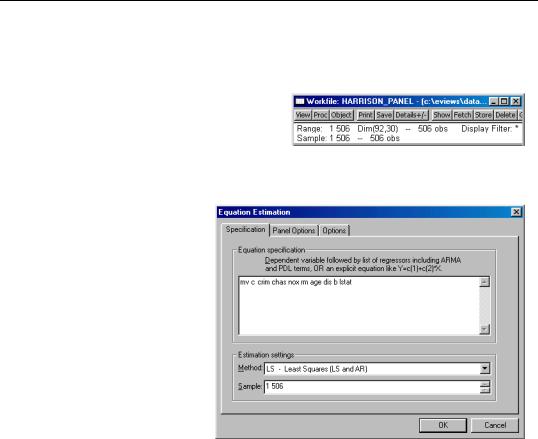
Panel Estimation Examples—909
select Undated Panel, and enter “TOWNID” as the Identifier series. EViews will prompt you twice to create a CELLID series to uniquely identify observations. Click on OK to both questions to accept your settings.
EViews restructures your workfile so that it is an unbalanced panel workfile. The top portion of the workfile window will change to show the undated structure which has 92 cross-sections and a maximum of 30 observations in a cross-section.
Next, we open the equation specification dialog by selecting Quick/Estimate Equation from the main EViews menu.
First, following Baltagi and Chang (1994) (also described in Baltagi, 2001), we estimate a fixed effects specification of a hedonic housing equation. The dependent variable in our specification is the median value MV, and the regressors are the crime rate (CRIM), a
dummy variable for the property along Charles River (CHAS), air pollution (NOX), average number of rooms (RM), proportion of older units (AGE), distance from employment centers (DIS), proportion of African-Americans in the population (B), and the proportion of lower status individuals (LSTAT). Note that you may include a constant term C in the specification. Since we are estimating a fixed effects specification, EViews will add one if it is not present so that the fixed effects estimates are relative to the constant term and add up to zero.
Click on the Panel Options tab and select Fixed for the Cross-section effects. To match the Baltagi and Chang results, we will leave the remaining settings at their defaults. Click on OK to accept the specification.

910—Chapter 29. Panel Estimation
Dependent Variable: MV
Method: Panel Least Squares
Date: 02/16/04 Time: 12:07
Sample: 1 506
Cross-sections included: 92
Total panel (unbalanced) observations: 506
Variable |
Coefficient |
Std. Error |
t-Statistic |
Prob. |
|
|
|
|
|
|
|
|
|
|
C |
8.993272 |
0.134738 |
66.74632 |
0.0000 |
CRIM |
-0.625400 |
0.104012 |
-6.012746 |
0.0000 |
CHAS |
-0.452414 |
0.298531 |
-1.515467 |
0.1304 |
NOX |
-0.558938 |
0.135011 |
-4.139949 |
0.0000 |
RM |
0.927201 |
0.122470 |
7.570833 |
0.0000 |
AGE |
-1.406955 |
0.486034 |
-2.894767 |
0.0040 |
DIS |
0.801437 |
0.711727 |
1.126045 |
0.2608 |
B |
0.663405 |
0.103222 |
6.426958 |
0.0000 |
LSTAT |
-2.453027 |
0.255633 |
-9.595892 |
0.0000 |
|
|
|
|
|
|
|
|
|
|
Effects Specification
Cross-section fixed (dummy variables)
R-squared |
0.918370 |
Mean dependent var |
9.942268 |
Adjusted R-squared |
0.898465 |
S.D. dependent var |
0.408758 |
S.E. of regression |
0.130249 |
Akaike info criterion |
-1.063668 |
Sum squared resid |
6.887683 |
Schwarz criterion |
-0.228384 |
Log likelihood |
369.1080 |
F-statistic |
46.13805 |
Durbin-Watson stat |
1.999986 |
Prob(F-statistic) |
0.000000 |
|
|
|
|
|
|
|
|
The results for the fixed effects estimation are depicted here. Note that as in pooled estimation, the reported R-squared and F-statistics are based on the difference between the residuals sums of squares from the estimated model, and the sums of squares from a single constant-only specification, not from a fixed-effect-only specification. Similarly, the reported information criteria report likelihoods adjusted for the number of estimated coefficients, including fixed effects. Lastly, the reported Durbin-Watson stat is formed simply by computing the first-order residual correlation on the stacked set of residuals.
We may click on the Estimate button to modify the specification to match the WallaceHussain random effects specification considered by Baltagi and Chang. We modify the specification to include the additional regressors used in estimation, change the cross-sec- tion effects to be estimated as a random effect, and use the Options page to set the random effects computation method to Wallace-Hussain.
The top portion of the resulting output is given by:
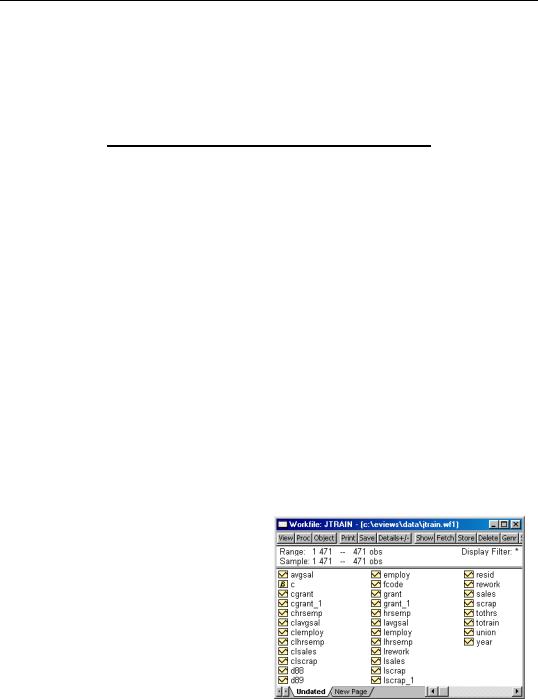
Panel Estimation Examples—911
Dependent Variable: MV
Method: Panel EGLS (Cross-section random effects)
Date: 02/16/04 Time: 12:28
Sample: 1 506
Cross-sections included: 92
Total panel (unbalanced) observations: 506
Wallace and Hussain estimator of component variances
Variable |
Coefficient |
Std. Error |
t-Statistic |
Prob. |
|
|
|
|
|
|
|
|
|
|
C |
9.684427 |
0.207691 |
46.62904 |
0.0000 |
CRIM |
-0.737616 |
0.108966 |
-6.769233 |
0.0000 |
ZN |
0.072190 |
0.684633 |
0.105443 |
0.9161 |
INDUS |
0.164948 |
0.426376 |
0.386860 |
0.6990 |
CHAS |
-0.056459 |
0.304025 |
-0.185703 |
0.8528 |
NOX |
-0.584667 |
0.129825 |
-4.503496 |
0.0000 |
RM |
0.908064 |
0.123724 |
7.339410 |
0.0000 |
AGE |
-0.871415 |
0.487161 |
-1.788760 |
0.0743 |
DIS |
-1.423611 |
0.462761 |
-3.076343 |
0.0022 |
RAD |
0.961362 |
0.280649 |
3.425493 |
0.0007 |
TAX |
-0.376874 |
0.186695 |
-2.018658 |
0.0441 |
PTRATIO |
-2.951420 |
0.958355 |
-3.079674 |
0.0022 |
B |
0.565195 |
0.106121 |
5.325958 |
0.0000 |
LSTAT |
-2.899084 |
0.249300 |
-11.62891 |
0.0000 |
|
|
|
|
|
|
|
|
|
|
|
Effects Specification |
|
|
|
|
|
|
|
|
|
|
|
|
|
Cross-section random S.D. / Rho |
|
0.126983 |
0.4496 |
|
Idiosyncratic random S.D. / Rho |
|
0.140499 |
0.5504 |
|
|
|
|
|
|
|
|
|
|
|
Note that the estimates of the component standard deviations must be squared to match the component variances reported by Baltagi and Chang (0.016 and 0.020, respectively).
Next, we consider an example of estimation with standard errors that are robust to serial correlation. For this example, we employ data on job training grants used in examples from Wooldridge (2002, p. 276 and 282).
As before, the first step is to structure the workfile as a panel workfile. Click on Range: to bring up the dialog, and enter “YEAR” as the date identifier and “FCODE” as the cross-section ID.
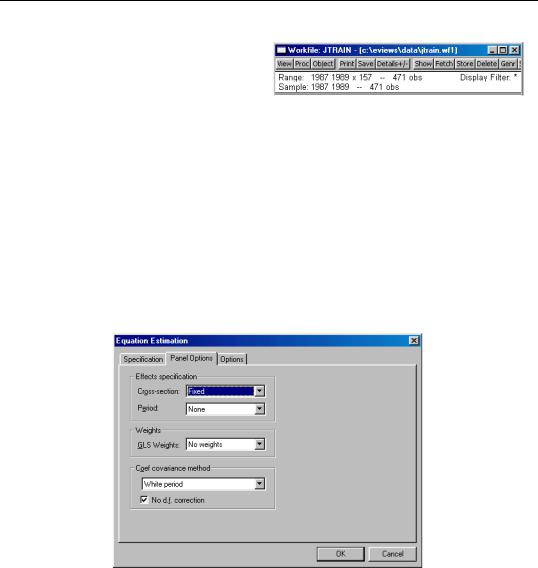
912—Chapter 29. Panel Estimation
EViews will structure the workfile so that it is a panel workfile with 157 cross-sections, and three annual observations. Note that even though there are 471 observations in the workfile, a
large number of them contain missing values for variables of interest.
To estimate the fixed effect specification with robust standard errors (Wooldridge example 10.5, p. 276), click on specification Quick/Estimate Equation from the main EViews menu. Enter the list specification:
lscrap c d88 d89 grant grant_1
in the Equation specification edit box on the main page and select Fixed in the Cross-sec- tion effects specification combo box on the Panel Options page. Lastly, since we wish to compute standard errors that are robust to serial correlation (Arellano (1987), White (1984)), we choose White period as the Coef covariance method. To match the reported Wooldridge example, we must select No d.f. correction in the covariance calculation.
Click on OK to accept the options. EViews displays the results from estimation:

Panel Estimation Examples—913
Dependent Variable: LSCRAP
Method: Panel Least Squares
Date: 02/16/04 Time: 13:28
Sample: 1987 1989
Cross-sections included: 54
Total panel (balanced) observations: 162
White period standard errors & covariance (no d.f. correction)
Variable |
Coefficient |
Std. Error |
t-Statistic |
Prob. |
|
|
|
|
|
|
|
|
|
|
C |
0.597434 |
0.062489 |
9.560565 |
0.0000 |
D88 |
-0.080216 |
0.095719 |
-0.838033 |
0.4039 |
D89 |
-0.247203 |
0.192514 |
-1.284075 |
0.2020 |
GRANT |
-0.252315 |
0.140329 |
-1.798022 |
0.0751 |
GRANT_1 |
-0.421589 |
0.276335 |
-1.525648 |
0.1301 |
|
|
|
|
|
|
|
|
|
|
Effects Specification
Cross-section fixed (dummy variables)
R-squared |
0.927572 |
Mean dependent var |
0.393681 |
Adjusted R-squared |
0.887876 |
S.D. dependent var |
1.486471 |
S.E. of regression |
0.497744 |
Akaike info criterion |
1.715383 |
Sum squared resid |
25.76593 |
Schwarz criterion |
2.820819 |
Log likelihood |
-80.94602 |
F-statistic |
23.36680 |
Durbin-Watson stat |
1.996983 |
Prob(F-statistic) |
0.000000 |
|
|
|
|
|
|
|
|
Note that EViews automatically adjusts for the missing values in the data. There are only 162 observations on 54 cross-sections used in estimation. The top portion of the output indicates that the results use robust White period standard errors with no d.f. correction.
Alternately, we may estimate a first difference estimator for these data with robust standard errors (Wooldridge example 10.6, p. 282). Open a new equation dialog by clicking on Quick/Estimate Equation..., or modify the existing equation by clicking on the Estimate button on the equation toolbar. Enter the specification:
d(lscrap) c d89 d(grant) d(grant_1)
in the Equation specification edit box on the main page, select None in the Cross-section effects specification combo box, and White period with No d.f. correction for the coefficient covariance method on the Panel Options page. The reported results are given by:

914—Chapter 29. Panel Estimation
Dependent Variable: D(LSCRAP)
Method: Panel Least Squares
Date: 02/16/04 Time: 14:51
Sample (adjusted): 1988 1988
Cross-sections included: 54
Total panel (balanced) observations: 108
White period standard errors & covariance (d.f. corrected)
Variable |
Coefficient |
Std. Error |
t-Statistic |
Prob. |
|
|
|
|
|
|
|
|
|
|
C |
-0.090607 |
0.089760 |
-1.009442 |
0.3151 |
D89 |
-0.096208 |
0.113117 |
-0.850519 |
0.3970 |
D(GRANT) |
-0.222781 |
0.131030 |
-1.700236 |
0.0921 |
D(GRANT_1) |
-0.351246 |
0.269704 |
-1.302339 |
0.1957 |
|
|
|
|
|
|
|
|
|
|
R-squared |
0.036518 |
Mean dependent var |
-0.221132 |
Adjusted R-squared |
0.008725 |
S.D. dependent var |
0.579248 |
S.E. of regression |
0.576716 |
Akaike info criterion |
1.773399 |
Sum squared resid |
34.59049 |
Schwarz criterion |
1.872737 |
Log likelihood |
-91.76352 |
F-statistic |
1.313929 |
Durbin-Watson stat |
1.498132 |
Prob(F-statistic) |
0.273884 |
|
|
|
|
|
|
|
|
While current versions of EViews do not provide a full set of specification tests for panel equations, it is a straightforward task to construct some tests using residuals obtained from the panel estimation.
To continue with the Wooldridge example, we may test for AR(1) serial correlation in the first-differenced equation by regressing the residuals from this specification on the lagged residuals using data for the year 1989. First, we save the residual series in the workfile.
Click on Proc/Make Residual Series... on the estimated equation toolbar, and save the residuals to the series RESID01.
Next, regress RESID01 on RESID01(-1), yielding:

Panel Estimation Examples—915
Dependent Variable: RESID01
Method: Panel Least Squares
Date: 02/16/04 Time: 14:57
Sample (adjusted):
Cross-sections included: 54
Total panel (balanced) observations: 54
Variable |
Coefficient |
Std. Error |
t-Statistic |
Prob. |
|
|
|
|
|
|
|
|
|
|
RESID01(-1) |
0.236906 |
0.133357 |
1.776481 |
0.0814 |
|
|
|
|
|
|
|
|
|
|
R-squared |
0.056199 |
Mean dependent var |
2.06E-18 |
|
Adjusted R-squared |
0.056199 |
S.D. dependent var |
0.571061 |
|
S.E. of regression |
0.554782 |
Akaike info criterion |
1.677863 |
|
Sum squared resid |
16.31252 |
Schwarz criterion |
1.714696 |
|
Log likelihood |
-44.30230 |
Durbin-Watson stat |
0.000000 |
|
|
|
|
|
|
|
|
|
|
|
Under the null hypothesis that the original idiosyncratic errors are uncorrelated, the residuals from this equation should have an autocorrelation coefficient of -0.5. Here, we obtain an estimate of ρˆ 1 = 0.237 which appears to be far from the null value. A formal Wald hypothesis test rejects the null that the original idiosyncratic errors are serially uncorrelated:
Wald Test:
Equation: Untitled
Test Statistic |
Value |
df |
Probability |
|
|
|
|
|
|
|
|
F-statistic |
26.60396 |
(1, 53) |
0.0000 |
Chi-square |
26.60396 |
1 |
0.0000 |
|
|
|
|
|
|
|
|
Null Hypothesis Summary: |
|
|
|
|
|
|
|
|
|
|
|
Normalized Restriction (= 0) |
Value |
Std. Err. |
|
|
|
|
|
|
|
|
|
0.5 + C(1) |
|
0.736906 |
0.142869 |
|
|
|
|
|
|
|
|
Restrictions are linear in coefficients.
Instrumental Variables Example
To illustrate the estimation of instrumental variables panel estimators, we consider an example taken from Papke (1994) for enterprise zone data for 22 communities in Indiana that is outlined in Wooldridge (2002, p. 306).
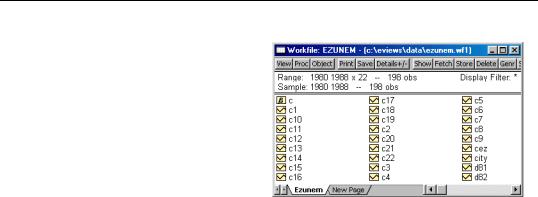
916—Chapter 29. Panel Estimation
The panel workfile for this example is structured using YEAR as the period identifier, and CITY as the cross-section identifier. The result is a balanced annual panel for dates from 1980 to 1988 for 22 cross-sections.
To estimate the example specification, create a new equation by typing “TSLS” in the command line, or by clicking on
Quick/Estimate Equation... in the
main menu. Selecting TSLS - Two-Stage Least Squares (and AR) in the Method combo box to display the instrumental variables estimator dialog, if necessary, and enter:
d(luclms) c d(luclms(-1)) d(ez)
to regress the difference of log unemployment claims (LUCLMS) on the lag difference, and the difference of enterprise zone designation (EZ). Since the model is estimated with time intercepts, you should click on the Panel Options page, and select Fixed for the Period effects.
Next, click on the Instruments tab, and add the names:
c d(luclms(-2)) d(ez)
to the Instrument list edit box. Note that adding the constant C to the regressor and instrument boxes is not required since the fixed effects estimator will add it for you. Click on OK to accept the dialog settings. EViews displays the output for the IV regression:

Panel Estimation Examples—917
Dependent Variable: D(LUCLMS)
Method: Panel Two-Stage Least Squares
Date: 02/16/04 Time: 17:11
Sample (adjusted): 1983 1988
Cross-sections included: 22
Total panel (balanced) observations: 132
Instrument list: C D(LUCLMS(-2)) D(EZ)
Variable |
Coefficient |
Std. Error |
t-Statistic |
Prob. |
|
|
|
|
|
|
|
|
|
|
C |
-0.201654 |
0.040473 |
-4.982442 |
0.0000 |
D(LUCLMS(-1)) |
0.164699 |
0.288444 |
0.570992 |
0.5690 |
D(EZ) |
-0.218702 |
0.106141 |
-2.060493 |
0.0414 |
|
|
|
|
|
|
|
|
|
|
|
Effects Specification |
|
|
|
|
|
|
|
|
|
|
|
|
|
Period fixed (dummy variables) |
|
|
|
|
|
|
|
|
|
|
|
|
|
|
R-squared |
0.280533 |
Mean dependent var |
-0.235098 |
|
Adjusted R-squared |
0.239918 |
S.D. dependent var |
0.267204 |
|
S.E. of regression |
0.232956 |
Sum squared resid |
6.729300 |
|
Durbin-Watson stat |
2.857769 |
J-statistic |
|
9.39E-29 |
Instrument rank |
8.000000 |
|
|
|
|
|
|
|
|
|
|
|
|
|
Note that the instrument rank in this equation is 8 since the period dummies also serve as instruments, so you have the 3 instruments specified explicitly, plus 5 for the non-collinear period dummy variables.
GMM Example
To illustrate the estimation of dynamic panel data models using GMM, we employ the unbalanced 1031 observation panel of firm level data from Layard and Nickell (1986), previously examined by Arellano and Bond (1991). The analysis fits the log of employment
(N) to the low of the real wage (W), log of the capital stock (K), and the log of industry output (YS).
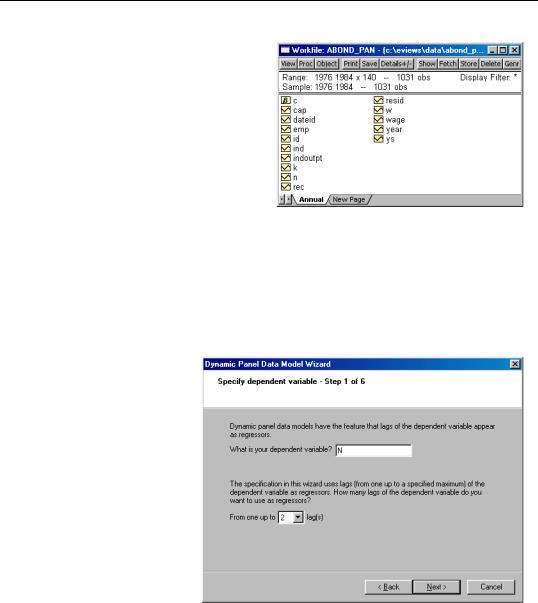
918—Chapter 29. Panel Estimation
The workfile is structured as a dated annual panel using ID as the cross-sec- tion identifier series and YEAR as the date classification series.
Since the model is assumed to be dynamic, we employ EViews tools for estimating dynamic panel data models. To bring up the GMM dialog, enter “GMM” in the command line, or select
Quick/Estimate Equation... from the main menu, and choose GMM/DPD -
Generalized Method of Moments /Dynamic Panel Data in the Method combo box to display the IV estimator dialog.
Click on the button labeled Dynamic Panel Wizard... to bring up the DPD wizard. The DPD wizard is a tool that will aid you in filling out the general GMM dialog. The first page is an introductory screen describing the basic purpose of the wizard. Click Next to continue.
The second page of the wizard prompts you for the dependent variable and the number of its lags to include as explanatory variables. In this example, we wish to estimate an equation with N as the dependent variable and N(-1) and N(-2) as explanatory variables so we enter “N” and select “2” lags in the combo box. Click on Next to continue to the next page, where you will specify the
remaining explanatory variables.
In the third page, you will complete the specification of your explanatory variables. First, enter the list:
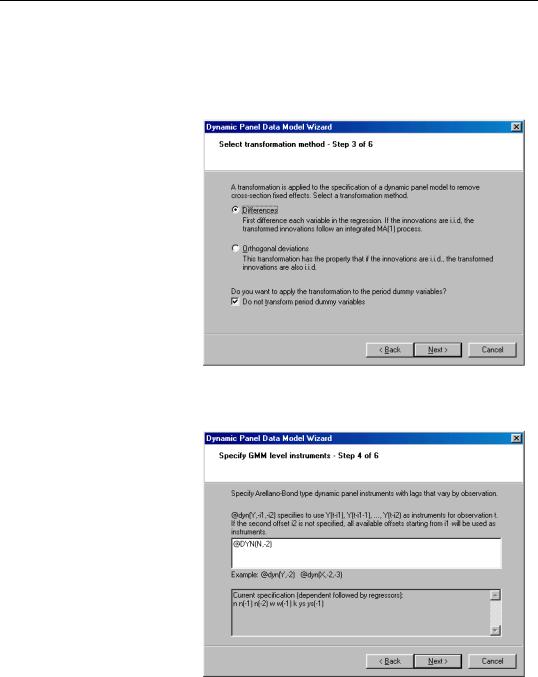
Panel Estimation Examples—919
w w(-1) k ys ys(-1)
in the regressor edit box to include these variables. Since the desired specification will include time dummies, make certain that the checkbox for Include period dummy variables is selected, then click on Next to proceed.
The next page of the wizard is used to specify a transformation to remove the cross-section fixed effect. You may choose to use first Differences or Orthogonal deviations. In addition, if your specification includes period dummy variables, there is a checkbox asking whether you wish to transform the period dummies, or to enter them in levels. Here we specify the first difference transforma-
tion, and choose to include untransformed period dummies in the transformed equation. Click on Next to continue.
The next page is where you will specify your dynamic period-specific (predetermined) instruments. The instruments should be entered with the “@DYN” tag to indicate that they are to be expanded into sets of predetermined instruments, with optional arguments to indicate the lags to be included. If no arguments are provided, the default is to include all valid lags (from -2 to “-infinity”).
Here, we instruct EViews that we wish to use the default lags for N as predetermined instruments.
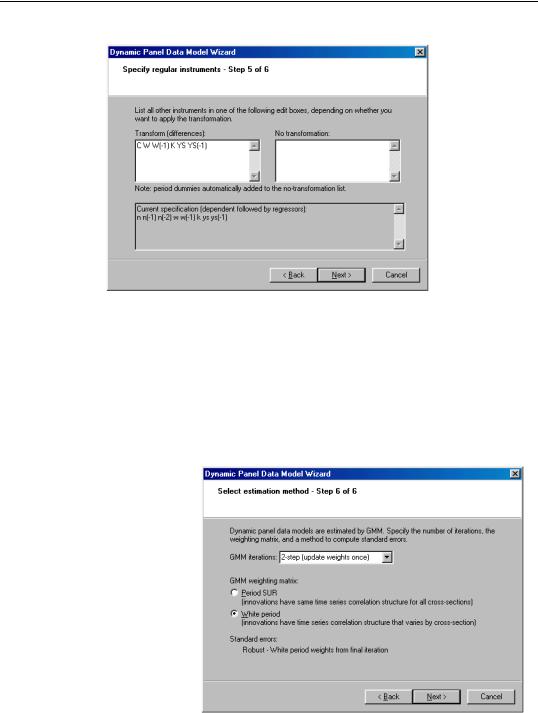
920—Chapter 29. Panel Estimation
You should now specify the remaining instruments. There are two lists that should be provided. The first list, which is entered in the edit field labeled Transform, should contain a list of the strictly exogenous instruments that you wish to transform prior to use in estimating the transformed equation. The second list, which should be entered in the No transform edit box should contain a list of instruments that should be used directly without transformation. Enter the remaining instruments:
w w(-1) k ys ys(-1)
in the first edit box and click on Next to proceed to the final page.
The final page allows you to specify your GMM weighting and coefficient covariance calculation choices. In the first combo box, you will choose a GMM Iteration option. You may select 1-step (for i.i.d. innovations) to compute the ArellanoBond 1-step estimator, 2- step (update weights once), to compute the Arellano-Bond 2-step estimator, or n-step (iterate

Panel Estimation Examples—921
to convergence), to iterate the weight calculations. In the first case, EViews will provide you with choices for computing the standard errors, but here only White period robust standard errors are allowed. Clicking on Next takes you to the final page. Click on Finish to return to the Equation Estimation dialog.
EViews has filled out the Equation Estimation dialog with our choices from the DPD wizard. You should take a moment to examine the settings that have been filled out for you since, in the future, you may wish to enter the specification directly into the dialog without using the wizard. You may also, of course, modify the settings in the dialog prior to continuing. For example, click on the Panel Options tab and check the No d.f. correction setting in the covariance calculation to match the original Arellano-Bond results (Table 4(b), p. 290). Click on OK to estimate the specification.
The top portion of the output describes the estimation settings, coefficient estimates, and summary statistics. Note that both the weighting matrix and covariance calculation method used are described in the top portion of the output.
Dependent Variable: N
Method: Panel Generalized Method of Moments
Transformation: First Differences
Date: 05/29/03 Time: 11:50
Sample (adjusted): 1978 1984
Number of cross-sections used: 140
Total panel (unbalanced) observations: 611
White period instrument weighting matrix
Linear estimation after one-step weighting
Instrument list: W W(-1) K YS YS(-1) @DYN(N) @LEV(@SYSPER)
Variable |
Coefficient |
Std. Error |
t-Statistic |
Prob. |
|
|
|
|
|
|
|
|
|
|
N(-1) |
0.474150 |
0.085303 |
5.558409 |
0.0000 |
N(-2) |
-0.052968 |
0.027284 |
-1.941324 |
0.0527 |
W |
-0.513205 |
0.049345 |
-10.40027 |
0.0000 |
W(-1) |
0.224640 |
0.080063 |
2.805796 |
0.0052 |
K |
0.292723 |
0.039463 |
7.417748 |
0.0000 |
YS |
0.609775 |
0.108524 |
5.618813 |
0.0000 |
YS(-1) |
-0.446371 |
0.124815 |
-3.576272 |
0.0004 |
@LEV(@ISPERIOD("1979")) |
0.010509 |
0.007251 |
1.449224 |
0.1478 |
@LEV(@ISPERIOD("1980")) |
0.014142 |
0.009959 |
1.420077 |
0.1561 |
@LEV(@ISPERIOD("1981")) |
-0.040453 |
0.011551 |
-3.502122 |
0.0005 |
@LEV(@ISPERIOD("1982")) |
-0.021640 |
0.011891 |
-1.819843 |
0.0693 |
@LEV(@ISPERIOD("1983")) |
-0.001847 |
0.010412 |
-0.177358 |
0.8593 |
@LEV(@ISPERIOD("1984")) |
-0.010221 |
0.011468 |
-0.891270 |
0.3731 |
|
|
|
|
|
|
|
|
|
|
